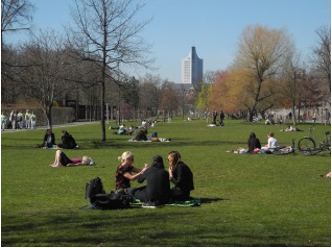Focus 2
Urban blue-green transformations
Solutions for multifunctionality and resilience

Urban blue-green infrastructures (UBGI) - e.g. street trees, parks, green roofs and facades - have a positive impact on health and well-being and make our cities more resilient. At the same time, UBGI are at the centre of numerous, sometimes conflicting interests that need to be reconciled in a sensible and sustainable way. In cooperation with various UFZ departments as well as other research institutions and practical partners, the priority area 'Urban blue-green transformations' is therefore dedicated to the following tasks:
Tasks
Our tasks comprise:
- analysis, development and implementation of multifunctional UBGI adapted to current and future challenges;
- research into the diverse ecosystem services of UBGI and their suitability as nature-based solutions to various challenges;
- identification and analysis of barriers, conflicts and contradictions and their interlinkages in the implementation of blue-green infrastructures and developing possible solutions;
- identification of relevant actors, social and political processes, and legal regulations that affect the implementation of UBGI projects and strategies, and development of solutions for improved legal structures;
- the significance of co-creation to support blue-green transformation: actors, models, transformative potential for innovations, Living Labs.
Projects
Projects we are currently leading, participating in, and building upon include:
- Fact Check Biodiversity with sub-project on urban areas
- Helmholtz Climate Initiative with sub-project Urban Systems
- KoopLab − Participation through Cooperative Open Space Development. Collaborating to Develop “Arrival Neighborhoods”
- Leipziger BlauGrün
- Ostpartnerschaften
- Perceptions on Nature-based solutions in flood contexts
- RECONECT
- REGREEN
- KlimaKonform/RegIKlim with sub-project on green infrastructure on municipal level
- EmpowerUs
Contact
Niels Wollschläger, Department of Urban and Environmental Sociology, and Dr. Diana Dushkova, Department of Conservation Biology & Social-Ecological Systems
